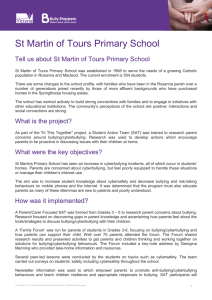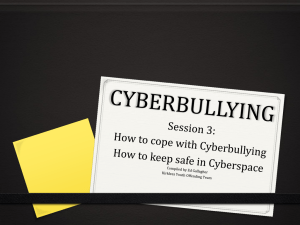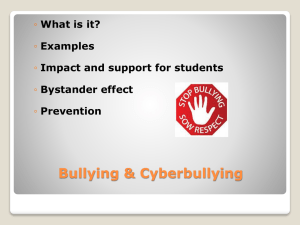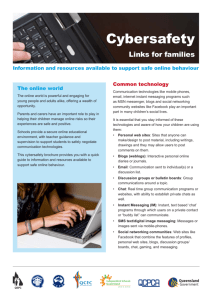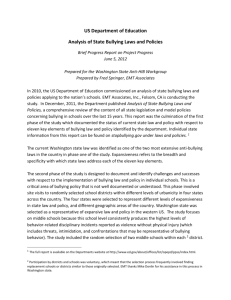Responsible technology use in public schools
advertisement
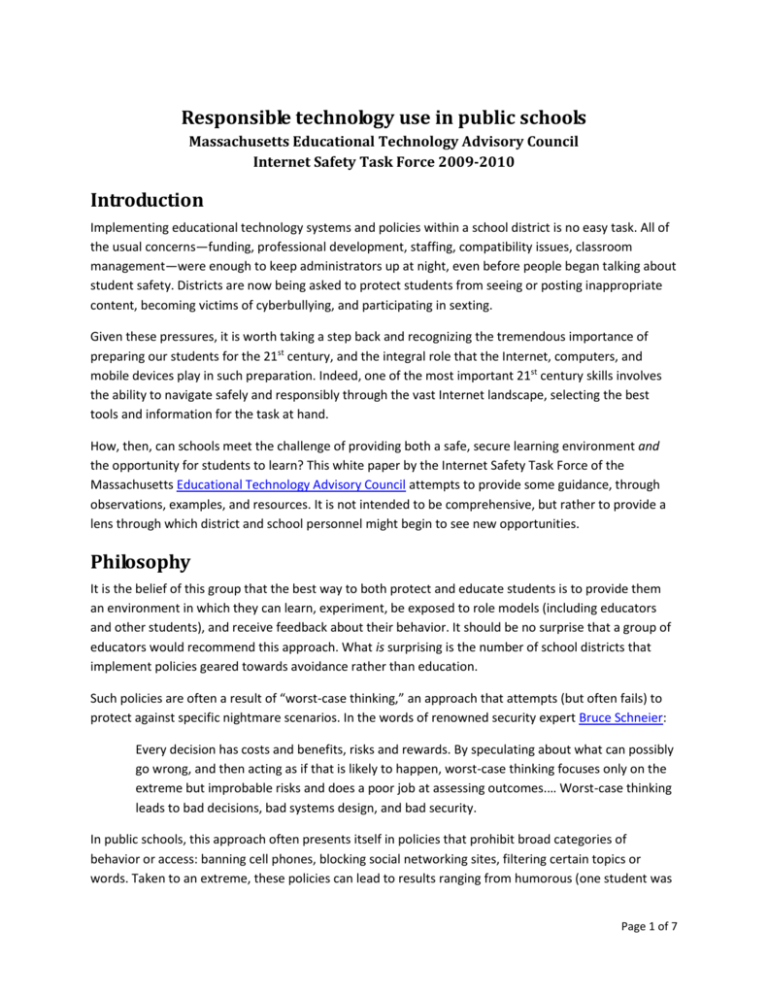
Responsible technology use in public schools Massachusetts Educational Technology Advisory Council Internet Safety Task Force 2009-2010 Introduction Implementing educational technology systems and policies within a school district is no easy task. All of the usual concerns—funding, professional development, staffing, compatibility issues, classroom management—were enough to keep administrators up at night, even before people began talking about student safety. Districts are now being asked to protect students from seeing or posting inappropriate content, becoming victims of cyberbullying, and participating in sexting. Given these pressures, it is worth taking a step back and recognizing the tremendous importance of preparing our students for the 21st century, and the integral role that the Internet, computers, and mobile devices play in such preparation. Indeed, one of the most important 21st century skills involves the ability to navigate safely and responsibly through the vast Internet landscape, selecting the best tools and information for the task at hand. How, then, can schools meet the challenge of providing both a safe, secure learning environment and the opportunity for students to learn? This white paper by the Internet Safety Task Force of the Massachusetts Educational Technology Advisory Council attempts to provide some guidance, through observations, examples, and resources. It is not intended to be comprehensive, but rather to provide a lens through which district and school personnel might begin to see new opportunities. Philosophy It is the belief of this group that the best way to both protect and educate students is to provide them an environment in which they can learn, experiment, be exposed to role models (including educators and other students), and receive feedback about their behavior. It should be no surprise that a group of educators would recommend this approach. What is surprising is the number of school districts that implement policies geared towards avoidance rather than education. Such policies are often a result of “worst-case thinking,” an approach that attempts (but often fails) to protect against specific nightmare scenarios. In the words of renowned security expert Bruce Schneier: Every decision has costs and benefits, risks and rewards. By speculating about what can possibly go wrong, and then acting as if that is likely to happen, worst-case thinking focuses only on the extreme but improbable risks and does a poor job at assessing outcomes.… Worst-case thinking leads to bad decisions, bad systems design, and bad security. In public schools, this approach often presents itself in policies that prohibit broad categories of behavior or access: banning cell phones, blocking social networking sites, filtering certain topics or words. Taken to an extreme, these policies can lead to results ranging from humorous (one student was Page 1 of 7 unable to do a report on his Congressman, Dick Armey, due to a keyword filter) to truly restrictive (a new policy in one Massachusetts district limits teachers and students to using only online services that have been approved by, and signed contracts with, the district). To truly educate and protect our students, districts have to find more nuanced approaches to technology. A recent study in UK grade schools found that when schools provided students with latitude in their online use, and teachers corrected inappropriate behavior, the students learned more about cybersafety than in schools where students were “protected” behind strict filters. Professor Craig Cunningham recommends giving teachers the ability to override filters when they block access to educationally relevant content. This allows educators to exercise judgment in the classroom, which opens up additional online resources and in some cases presents a teachable moment for students. Filtering, however, is only one small part of educational technology systems and policies. The remainder of this document recommends resources for addressing a variety of technology issues through the lens of protecting students through education rather than restriction. "Swimming pools can be dangerous for children. To protect them, one can install locks, put up fences, and deploy pool alarms. All these measures are helpful, but by far the most important thing one can do for one's children is to teach them to swim." –Dick Thornburgh and Herbert S. Lin Resources The resources below are in addition to an extensive set of materials that can be found on MassONE in the TLR section. ETAC did not evaluate the MassONE materials against the philosophy espoused above. Cyberbullying Cyberbullying, and school bullying in general, have been in the news a lot in recent months. Here in Massachusetts, new legislation requires schools to take a more active role in the prevention and reporting of bullying, whether it occurs on school grounds or not. Nancy Willard’s Center for Safe and Responsible Internet Use (CSRIU) offers materials, such as the “Educator’s Guide to Cyberbullying,” that address cyberbullying from the perspective of building a safe school environment. Elizabeth Englander’s Massachusetts Aggression Reduction Center (MARC) also offers materials and programs for educators aimed at changing school culture to one that does not accept bullying. MARC collaborated with the Massachusetts Department of Elementary and Secondary Education to post bullying prevention resources for parents, as well. The non-profit Middlesex Partnerships for Youth serves as both a resource for districts (it offers professional development and events related to student safety) and as an example of a successful model where law enforcement and school districts have come together to address cybersafety and other student safety issues. Page 2 of 7 The Massachusetts Attorney General’s office has a page about school bully prevention programs, though it does not (yet) provide any legal guidance for schools in complying with the new legislation. It does, however, link to a great Guide to Bullying Prevention from the Commonwealth. A more student-centric resource is the “Time for Tolerance” website, which was developed by children, for children (it says for ages 9-16, but 9-13 would probably be more accurate). This site focuses its message on building “acceptance and respect for the differences between people.” Here, bullying is treated not as an isolated problem, but one which is an obstacle to the positive goal of building mutual respect. Cyberbullying, in turn, is not treated as something that exists on its own, but rather as a particular form of bullying. The site also has a page with advice for schools on how to combat bullying. Safety and security advice for students The surest way to get a child to reach into a cookie jar is to tell him that he shouldn’t; there’s even research on the subject. By all accounts, the “Just Say No to Drugs” campaign in the 1980s was a failure. Yet most cyber security and cyber safety materials for K-12 students take this same approach, listing all of the things kids shouldn’t do online, often in a tone that is perceived as dictatorial rather than informative. In contrast, the guides produced by WiredSafety and distributed by Cisco for tweens and teenagers focus on building skills that will continue to be useful throughout the child’s life: when and whom to ask for help, how to choose a safe password, how to navigate the web without falling victim to common traps, etc. The tone of these guides is conversational, gently directing their audiences to make good choices and to develop positive online habits. Involving parents Navigating online space effectively and safely is a life skill, just like navigating a city. Parents play a critical role in modeling behavior, setting expectations, monitoring out-of-school technology use, and responding appropriately to their children’s concerns. The Federal Trade Commission recently published a guide for parents on how to talk with their kids about being online. (The guide is also available in Spanish and printed.) The guide emphasizes the importance of open communication and educates parents on everything from cyberbullying to parental control software. A similar but briefer guide for parents can be found at ConnectSafely.org. Rethinking acceptable use policies Many acceptable use policies for students read like a list of unacceptable uses, often with a heavy dose of legalese. Written well, however, an acceptable use policy (or, stated more positively, a responsible use policy) can serve to educate and protect the district. An ideal acceptable/responsible use policy should be written for students, not for lawyers, and should present clear expectations for student behavior when using district technology resources. The Australian Page 3 of 7 state of Victoria has an outstanding template [in Word format] that is notable for the way it outlines good behavior while defining clear rules that can be enforced in the classroom. (It’s also interesting that the Victoria schools require the student and the parent/guardian to sign the policy.) Integrating responsible use into the curriculum In 2004, Patty Yamano at Pepperdine University studied how prepared fourth and fifth grade teachers feel in teaching their students about cyberethics. She found that while most teachers, as adults, have a strong sense of personal ethics and are able to practice that in cyberspace, they have a great deal of difficulty transferring that moral understanding into teaching cyberethics to their students. She also found that even those teachers who were teaching cyberethics were doing so in direct instruction rather than through activities and discussion, the kinds of interactive process so necessary in developing judgment. Patty Yamano's research shows that to help teachers be most effective in teaching and practicing the everyday acts of ethical behavior in cyberspace, they also need to be educated in using technology in the classroom and in the integration of curriculum objectives and technology resources. Yamano found that these competencies are the functional prerequisites to learning and teaching cyberethics. If teachers do not know how to use technology and are not comfortable integrating technology in their teaching, they will be less able to help their students learn ethical behavior in cyberspace (Whittier, 2006). The CyberSmart Curriculum’s lesson on managing project teams provides a great example of how to integrate technology use into a lesson about teamwork. The tools and the teamwork skills that students are exposed to in this lesson can be adapted for broader use within the classroom. This would allow an ongoing opportunity for students to experiment with, and be guided in the responsible use of, collaborative online environments. Further reading TeachPaperless is a blog about integrating social technology into the classroom. Classroom 2.0 is a self-contained social network that focuses on the use of social networking and web 2.0 technology in educational environments. TeachEng.us has a bunch of great ideas about how teachers can embrace technology. It’s geared toward English teachers, though many of the ideas are universal. Weblogg-ed presents a more theoretical dialog about the changing face of education, with a strong bias towards embracing technology and open access in the classroom. Tools for the 21st Century Teacher is an e-book that describes a bunch of web-based tools and how they may be helpful to educators. Page 4 of 7 The Spartanburg (South Carolina) District 7 Technology Blog is a great example of how a district’s instructional technology department communicates with district personnel. It also highlights many examples of innovative use of technology within districts. CyberSafety in the Classroom is an article in the June 2010 issue of DistrictAdministration that describes how some experts recommend, and how some districts are implementing integrated cybersafety education. Technological Pedagogical Content Knowledge (TPCK) is a framework put forth by Punya Mishra and Matthew J. Koehler of Michigan State for understanding and improving teaching. It reinvents Lee Shulman’s widely adopted Pedagogical Content Knowledge (PCK) framework, emphasizing technology integration as a key part of pedagogy. Contributors This document was created by the Internet Safety Task Force of the Educational Technology Advisory Council, which advises the Massachusetts Board of Elementary and Secondary Education. The task force for 2009-2010 included: Shelley B. Chamberlain, Director of Information Technology, Newton Public Schools Edwin Guarin, Academic Developer Evangelist, Microsoft Charles F. Kilfoye, Director of Instructional Technology, Northeastern University Online Steven Mazzola, Director of Technology, Belmont Public Schools Anne K. Sheehy, Instructional Technology Specialist, Lowell Public Schools Thomas J. Stella, Assistant Superintendent, Everett Public Schools Maxim Weinstein (task force co-chair), Executive Director, StopBadware David Whittier (task force co-chair), Assistant Professor, Boston University School of Education References Print Butler, Kevin. “Cybersafety in the Classroom.” District Administration, June 2010. Fisher, Jennifer Orlet, and Leann Lipps Birch. “Restricting access to palatable foods affects children’s behavioral response, food selection, and intake.” American Journal of Clinical Nutrition, Vol. 69, No. 6, 1264-1272, June 1999. Mishra, P., & Koehler, M. J. “Technological Pedagogical Content Knowledge: A new framework for teacher knowledge.” Teachers College Record. 108(6), 1017-1054. Shulman, Lee S. “Those Who Understand: Knowledge Growth in Teaching.” Educational Researcher, Vol. 15, No. 2 (Feb., 1986), pp. 4-14. Thornburgh, Dick, and Herbert S. Lin. Youth, Pornography, and the Internet. National Academies Press, 2002. Page 5 of 7 Yamano, P. “Cyberethics in the Elementary Classroom: Teaching Responsible Use of Technology.” Proceedings of Society for Information Technology & Teacher Education International Conference 2006, 3667-3670. Chesapeake, VA: AACE. Whittier, David. “Cyberethics in the Googling Age.” Journal of Education, Vol. 187, No. 2, 1-6, Spring 2006. Web http://www.doe.mass.edu/boe/sac/edtech/ http://www.schneier.com/blog/archives/2010/05/worst-case_thin.html http://blogs.computerworld.com/15824/a_simple_fix_for_internet_censorship_in_schools http://www.nap.edu/openbook.php?record_id=10261&page=9 http://www.mass.gov/legis/laws/seslaw10/sl100092.htm http://csriu.org/ http://www.csriu.org/cyberbully/ http://www.csriu.org/cyberbully/docs/cbcteducator.pdf http://webhost.bridgew.edu/marc/index.html http://www.doe.mass.edu/ssce/bullying/ http://www.middlesexpartnershipsforyouth.com/ http://www.mass.gov/?pageID=cagoterminal&L=4&L0=Home&L1=Community+Safety&L2=Schools+%26 +Youth&L3=School+Climate&sid=Cago&b=terminalcontent&f=community_bully_prevention_programs& csid=Cago http://www.mass.gov/Eeohhs2/docs/dph/com_health/violence/bullying_prevent_guide.pdf http://library.thinkquest.org/07aug/00117/index1.html http://library.thinkquest.org/07aug/00117/schools.html http://www.ajcn.org/cgi/content/full/69/6/1264 http://www.linksysbycisco.com/static/content/20090629/Kids_and_tweens_Cybersafety_WEB.pdf http://www.linksysbycisco.com/static/content/20090626/teen_cybersafety.pdf http://www.ftc.gov/bcp/edu/pubs/consumer/tech/tec04.pdf http://www.ftc.gov/bcp/edu/pubs/consumer/tech/stec04.pdf http://bulkorder.ftc.gov/ http://www.connectsafely.org/Safety-Tips/virtual-world-safety-tipsteens.html http://www.connectsafely.org/Safety-Tips/virtual-world-safety-tipsteens.html http://www.eduweb.vic.gov.au/edulibrary/public/teachlearn/ict/Acceptableuseagreementtemplatefors chools.doc http://www.editlib.org/p/22669 Page 6 of 7 http://www.eric.ed.gov/ERICWebPortal/custom/portlets/recordDetails/detailmini.jsp?_nfpb=true&_&E RICExtSearch_SearchValue_0=EJ762979&ERICExtSearch_SearchType_0=no&accno=EJ762979 http://cybersmartcurriculum.org/authentic/lessons/9-12/managing_project_teams/ http://teachpaperless.blogspot.com/ http://www.classroom20.com/ http://teacheng.us/ http://weblogg-ed.com/ http://issuu.com/mzimmer557/docs/tools_for_the_21st_century_teacher http://spart7.info/techblog/ http://www.districtadministration.com/viewarticle.aspx?articleid=2428 http://citeseerx.ist.psu.edu/viewdoc/download?doi=10.1.1.91.7990&rep=rep1&type=pdf http://www.jstor.org/stable/1175860 http://www.doe.mass.edu/boe/sac/edtech/ Page 7 of 7

